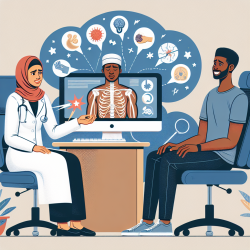Introduction
Wilson's Disease (WD) is a rare autosomal recessive disorder characterized by excessive copper accumulation in the body, leading to hepatic, neurological, and psychiatric symptoms. Understanding the neurological manifestations of WD is crucial for practitioners aiming to provide effective interventions, particularly in the context of online therapy services like those offered by TinyEYE.
Pathophysiology and Clinical Implications
The research article "Neurological Manifestations of Wilson's Disease: Pathophysiology and Localization of Each Component" provides a comprehensive overview of the neurological symptoms associated with WD. The study highlights the role of copper toxicity in brain degeneration, affecting various regions such as the basal ganglia, thalamus, and cerebellum. Key neurological manifestations include:
- Dysarthria: A motor speech disorder resulting from damage to the motor control structures necessary for speech production. While the study did not find a specific pathophysiological mechanism for dysarthria in WD, it suggests that multiple brain regions are involved.
- Cognitive Impairment: Includes frontal syndrome and subcortical dementia, often resulting from frontal lobe degeneration and copper deposition in the brain.
- Parkinsonism: Associated with nigrostriatal dopaminergic deficits and reduced ceruloplasmin levels, leading to copper and iron accumulation.
- Tremor: Can be an action tremor due to copper accumulation in the cerebellum or an essential tremor linked to the dentate nucleus.
- Dystonia: Characterized by involuntary muscle contractions, with MRI abnormalities often observed in the putamen.
Enhancing Practitioner Skills
Practitioners can enhance their skills by understanding the pathophysiology of these manifestations and their implications for therapy. Here are some ways to implement the research findings:
- Focus on Comprehensive Assessment: Use data-driven assessments to identify specific neurological symptoms in WD patients. This can guide personalized therapy plans.
- Incorporate Multidisciplinary Approaches: Collaborate with neurologists, psychiatrists, and speech-language pathologists to address the complex needs of WD patients.
- Utilize Advanced Imaging Techniques: MRI findings can provide insights into the extent of brain damage and help tailor interventions.
- Engage in Continuous Education: Stay updated with the latest research to refine therapeutic strategies and improve patient outcomes.
Encouraging Further Research
While the current study provides valuable insights, there are still gaps in understanding the full spectrum of neurological manifestations in WD. Practitioners are encouraged to engage in further research to explore these areas and contribute to the growing body of knowledge.
To read the original research paper, please follow this link: Neurological Manifestations of Wilson's Disease: Pathophysiology and Localization of Each Component.










